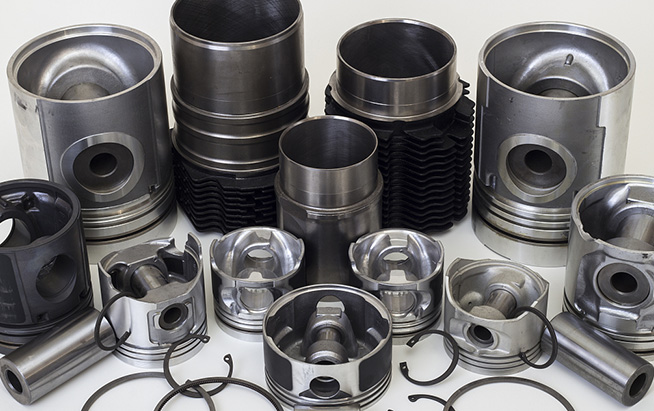Piston and Piston Rings
Aug. 07, 2025
A piston is a cylindrical component that moves back and forth within the cylinder bore, driven by the forces generated during combustion. It serves as the movable end of the combustion chamber, while the cylinder head forms the stationary end. Most pistons are made from cast aluminum alloy due to its light weight and excellent thermal conductivity—the ability to efficiently transfer heat. As aluminum expands when heated, adequate clearance must be maintained between the piston and cylinder wall. Too little clearance can cause the piston to seize, while too much can lead to compression loss and increased piston noise.
Key features of a piston include the piston head, skirt, pin bore, piston pin, ring grooves, ring lands, and piston rings. The piston head, which faces the combustion chamber, is exposed to intense heat and pressure during engine operation and must withstand extreme conditions.
The piston pin bore is a transverse hole through the piston, positioned perpendicular to its direction of travel. It houses the piston pin—a hollow shaft that connects the piston to the small end of the connecting rod. This connection allows the piston to pivot during engine operation. The skirt is the lower portion of the piston, located closest to the crankshaft. It helps maintain alignment as the piston moves within the cylinder bore. Some piston skirts feature cutouts or profiles to reduce weight and ensure clearance from the crankshaft’s counterweights.
Surrounding the piston are ring grooves—recessed channels that hold the piston rings. Each groove is bordered by two flat surfaces known as ring lands, which act as sealing surfaces for the piston rings. Piston rings are expandable split rings designed to seal the gap between the piston and the cylinder wall. Typically made from cast iron, they retain their shape under high heat, pressure, and dynamic stress. Piston rings perform several critical functions: they seal the combustion chamber, transfer heat from the piston to the cylinder wall, and scrape excess oil back to the crankcase. Their size, number, and design vary depending on the engine type and cylinder material.
Small engines typically use three types of piston rings: the compression ring, wiper ring, and oil ring. The compression ring is positioned in the uppermost ring groove, closest to the piston head. Its primary function is to seal the combustion chamber and prevent gas leakage during the combustion process.
When the air-fuel mixture ignites, combustion gases exert pressure on the piston head, driving the piston downward toward the crankshaft. Some of this pressure travels through the narrow space between the piston and the cylinder wall and into the ring groove. This gas pressure forces the compression ring outward against the cylinder wall, creating a tight seal. The amount of pressure applied to the piston ring is roughly proportional to the combustion gas pressure, ensuring the ring remains firmly seated during engine operation.
The wiper ring, positioned in the ring groove between the compression ring and the oil ring, features a tapered face. Its dual purpose is to enhance the seal of the combustion chamber and to scrape excess oil from the cylinder wall. Any combustion gases that may bypass the compression ring are intercepted by the wiper ring, further improving overall sealing performance.
The oil ring is located in the ring groove nearest to the crankcase. Its primary function is to remove excess oil from the cylinder wall during piston movement and return it through ring slots or holes to the engine’s oil reservoir. This helps maintain proper lubrication without allowing oil to enter the combustion chamber. In two-stroke engines, oil rings are not required because lubrication is achieved by mixing oil directly with the fuel, eliminating the need for a separate oil reservoir.
Piston rings serve three primary functions: sealing the combustion chamber, transferring heat from the piston to the cylinder wall, and regulating oil consumption. Effective sealing is achieved through both inherent pressure and applied pressure.
Inherent pressure refers to the internal spring force generated by the ring’s material and design. This force causes the piston ring to expand outward, pressing against the cylinder wall. The amount of inherent pressure is largely determined by the free piston ring gap—the distance between the two ends of the ring when it is uncompressed. Generally, a larger free gap results in greater outward force when the ring is installed in the cylinder bore. This force ensures a consistent and reliable radial fit, which is essential for maintaining an effective seal between the ring’s running surface and the cylinder wall, as well as between the ring and the piston ring lands.
In addition to inherent pressure, piston rings also rely on applied pressure to maintain combustion sealing. Applied pressure comes from combustion gases, which enter the piston ring groove during engine operation and force the ring outward against the cylinder wall. Some piston rings are designed with a chamfered edge on the side opposite the running surface. This design causes the ring to twist slightly when not under gas pressure, enhancing its sealing behavior under varying operating conditions.
One critical design factor for piston rings is cylinder wall contact pressure, which is influenced by the ring material’s elasticity, the free piston ring gap, and exposure to combustion gases. Briggs & Stratton engines exclusively use cast iron piston rings due to cast iron’s ability to conform easily to the cylinder wall and its compatibility with wear-resistant coatings. However, cast iron is also fragile and prone to distortion, so care must be taken during handling.
Briggs & Stratton small engines typically use three types of piston rings: compression rings, wiper rings, and oil rings, each serving a distinct role in sealing, lubrication, and thermal management.
Compression Ring
The compression ring is the topmost ring on the piston, directly exposed to combustion gases and subjected to the highest temperatures and chemical stresses. It plays a vital role in sealing the combustion chamber and is responsible for transferring approximately 70% of the piston’s heat to the cylinder wall.
Briggs & Stratton engines commonly use two compression ring designs:
Taper-faced compression rings feature a running surface with a slight 1° taper. This taper helps prevent oil from entering the combustion chamber by providing a gentle wiping action.
Barrel-faced compression rings have a curved running surface that ensures more consistent lubrication between the ring and the cylinder wall. The curvature also distributes oil more evenly across the piston stroke and reduces the risk of oil film breakdown caused by edge loading or piston tilt during operation.
Wiper Ring
The wiper ring, also known as a scraper ring, Napier ring, or back-up compression ring, is positioned just below the compression ring. It functions primarily to control the oil film on the cylinder wall and to intercept any combustion gases that bypass the compression ring.
Most Briggs & Stratton wiper rings have a tapered face, with the taper directed toward the crankcase. This configuration scrapes excess oil from the cylinder wall and channels it downward toward the oil ring. If installed incorrectly—taper facing the compression ring—the wiper ring can direct oil upward into the combustion chamber, resulting in excessive oil consumption.
Oil Ring
The oil ring is the lowest ring on the piston, nearest to the crankcase. It is designed specifically to manage oil by scraping excess from the cylinder wall and returning it to the engine's oil reservoir through slots or holes in the ring body. Oil rings come in both one-piece and three-piece designs:
One-piece oil rings typically include two thin rails and integrated oil return slots. Some are equipped with a spring expander to increase radial pressure, enhancing oil control by improving contact with the cylinder wall.
Three-piece oil rings consist of two rails and a central expander. The expander includes multiple openings to allow oil to flow back into the piston ring groove. This design provides higher unit pressure, which is the concentrated force applied to the cylinder wall due to the narrow surface of the thin rails, ensuring effective oil scraping.
Among the three types, oil rings exert the highest inherent pressure, allowing them to effectively manage lubrication without compromising sealing performance.
Piston Materials and Performance
The piston forms the movable end of the combustion chamber and must withstand high-pressure fluctuations, thermal stress, and mechanical forces during engine operation. Most pistons used in small engines are made from die-cast or gravity-cast aluminum alloys, which offer a combination of light weight, good thermal conductivity, structural strength, and cost-efficiency.
Aluminum’s low mass reduces the inertia of the piston, allowing more of the combustion energy to be converted into useful work. This enhances the efficiency and responsiveness of the engine. However, piston designs always reflect a balance of performance, durability, and manufacturing constraints, with each configuration optimized for specific engine applications.
25
0
0
None
None



Comments
All Comments (0)